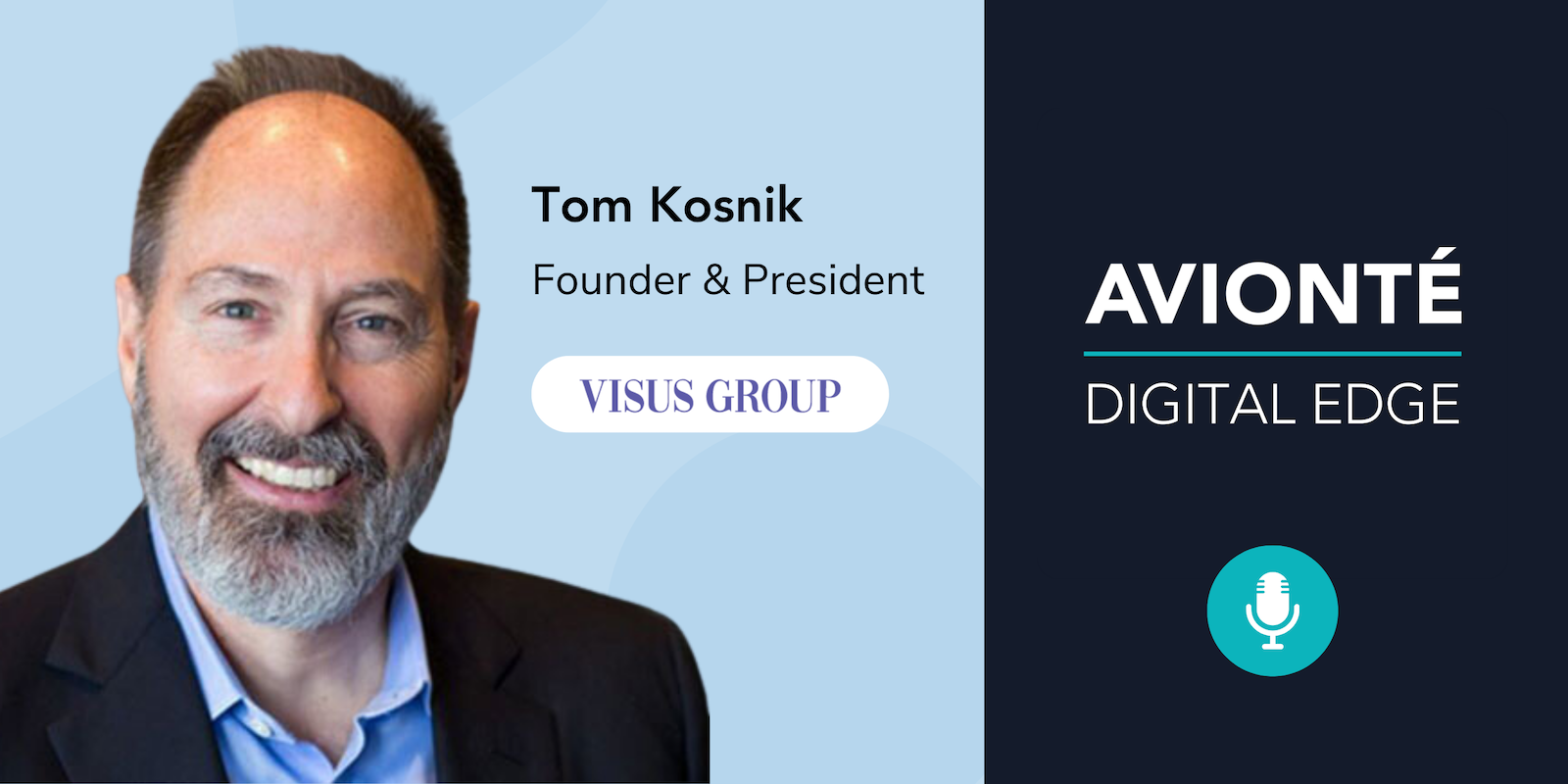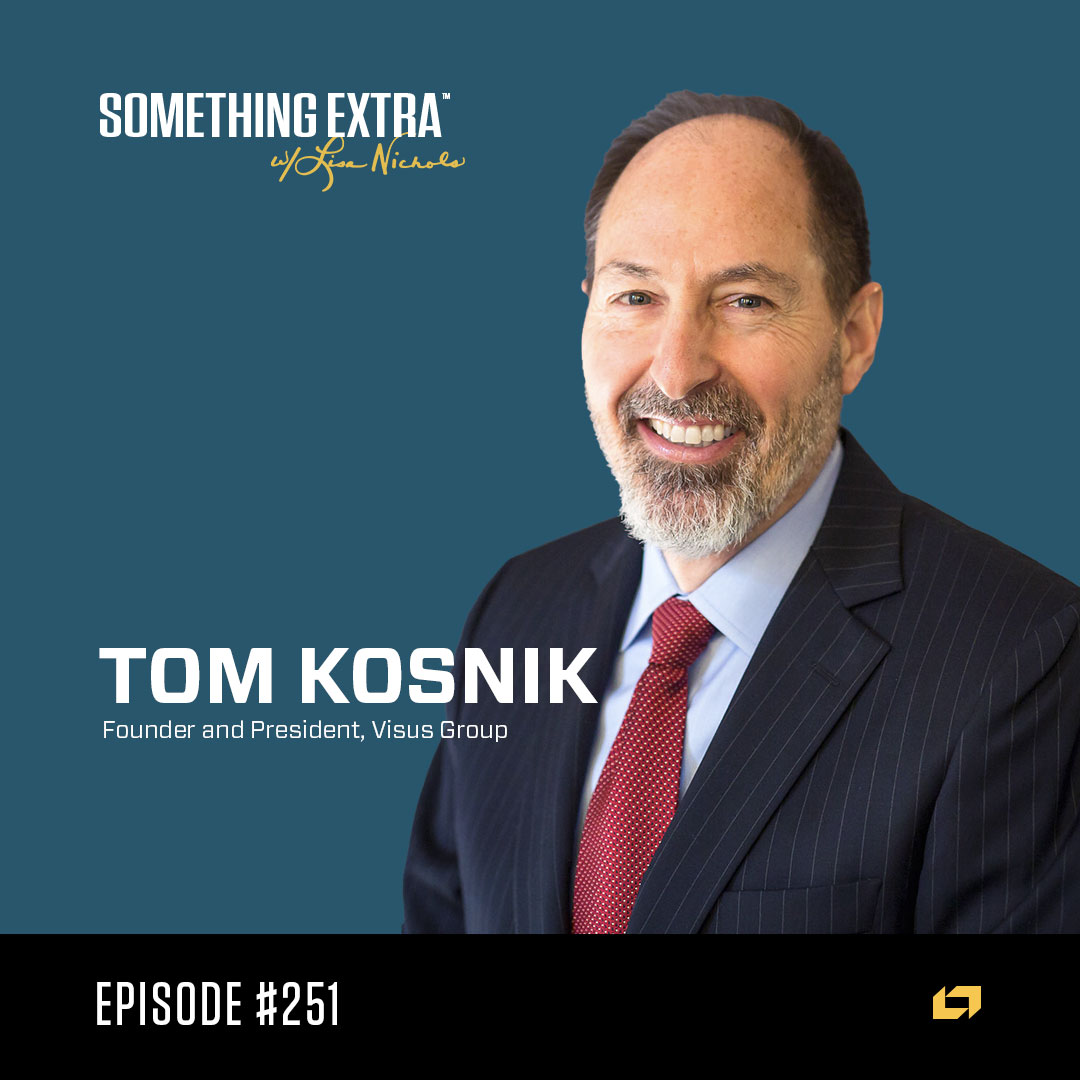What strategies can staffing leaders use to effectively engage with this new generation of workers? And how can we provide them with the necessary support to ensure their success as the upcoming leaders in this field? To help shed light on these questions, Christopher Ryan, Chief Marketing & Strategy Officer at Avionté, sits down with Tom Kosnik, President of Visus Group, LLC.
Continue readingThere are Good Things in the Short Straw
Tom Kosnik, President of Visus Group and Founder of Presidents' RoundTable, says he got into the staffing industry because he drew the shortest straw. Now, he will be the first to laugh and tell you that this was the best thing for him. Tune in as he and Lisa discuss the intersection of community and entrepreneurship, as well as the importance of examining your blind spots for business growth.
Continue readingStaffing Exclusive
Get ready to explore the shifting dynamics of staffing in today's job market. Tom's insights offer a roadmap for companies to adapt, thrive, and excel.
Continue readingHow to Build a Great Company Culture?
Todd Bavol, CEO and Co-Founder of Integrity Staffing Solution, shared a few tips in building a great culture.
Continue readingAll Lead Generation Tactics Are Not Equal
by Visus Group Partner Jay Mattern, CEO of TerraFirma Marketing
All Lead Generation Tactics Are Not Equal
If you are utilizing outbound marketing to generate leads, how can you stand out from the crowd and generate optimal results? And by results, I mean getting readers/subscribers to do more than just open an email. Here are seven tips that will help you convert more leads into sales.
1.Stay True to Your Brand
Too often, email campaigns are generic and fail to convey the solicitor’s branded message. While it’s important to tailor your message to the reader and address their needs, your brand still needs to come through loud and clear. Even if your email is short and to the point, it should always be created in your brand voice and reflect your messaging strategy.
2. Learn how to get and direct attention.
The email’s subject line is certainly important but getting them to go beyond that will require a purposeful design and compelling content. How can you use design to direct the reader’s attention? By using the elements of motion, size, color, and positioning, you can subtly yell at the reader — “HEY, LOOK AT ME!” Here are some specific ideas:
- Placing an element higher in the email is more recognizable than a lower one.
- An element that is in contrast with its surroundings is more recognizable than one which blends in.
- A larger element is more recognizable than one that is smaller.
- Bold and/or italicized font stands out when used sparingly.
3. Never forget that conversion is the primary goal.
You should always be asking yourself “what do I want the audience to do?” Ideally, you want them to respond to your Call to Action – to click on the CTA button. That’s what we mean by conversion. The ultimate end of your sales and recruiting process is undoubtedly more involved, but the immediate objective of an email or ad is always to motivate the reader to want to learn more. You need to open that door.
4. Triple-check everything.
Have you ever clicked on a CTA (converted!) and actually wound up on an “Error 404 – the requested URL was not found?” Or the click actually did nothing. It is imperative that you check all of your links to make sure they all work as promised. This is your first opportunity to deliver on something you promised, and a poor impression here takes you out of the running.
5. Make use of urgency.
It’s well known that we tend to want what we can’t have. When something is rare, exclusive, or limited, it immediately makes it more desirable and more in demand. Use this same approach in your email marketing efforts. Limit your offer. Make it clear that immediate action is necessary, whether it’s due to a timeline you set or a seasonal/business cycle. Convey a sense of urgency.
6. Get to the point.
The best lead generation emails are written understanding that the reader’s time is scarce and you’re competing for their attention. No one will take the time to search for your message. It’s your job to package and present it.
- Use bullet points to highlight key ideas. This will help the important takeaways easily stand out from the rest of the text.
- Strategically utilize imagery (a picture is still worth 1,000 words).
- Most important is a clear and inviting Call to Action. It should be just that – a “call” to the reader to do something.
7. Use landing pages.
To get the most from leads you generate, you should use a unique landing page designed specifically to convert the lead to the next step and move them into the lead funnel. A well-designed landing page will prevent the lead from being distracted by other messages or information that reside on your website and will focus them specifically on what the next step is.
Given the significant shift towards digital marketing and automated marketing solutions, getting a message through to a prospect or candidate is becoming increasingly more difficult. Your message must truly stand out and present itself uniquely in order to successfully engage the prospect. With deliberate focus and attention, you can optimize your email marketing results and more easily turn leads into results. And that is the ultimate goal.
When it comes to technology in your staffing firm, address these five areas first.
Technology in the staffing industry sure has evolved over the last few years. Right now, there are over 400 hundred technologies that are currently supporting the staffing industry. That’s right, 400+ technologies! How do you know which ones are new? How do you know where to start? How do you know which ones are the best ones for your staffing firm?
What I frequently hear from my clients and members is this: “I’m a business owner of a staffing firm, someone with a sales background. How can I possibly know how to make the right decision on technology?” It’s a valid question and one that has a variety of answers. The first step is to really analyze where you currently are on the technology spectrum ranging from low-technology firms, a smaller firm or one that doesn’t use too many products, to an enlightened staffing firm, one that has built out their tech stack and understands how to leverage their IT department for greater efficiency. The reality is that many are on the former side.
The good news is that we are in a unique position, through our Presidents RoundTable, to get exposure to all the IT challenges that staffing firms of all sizes face on a weekly basis. Through all of these stories and consulting moments, we’ve identified five critical areas that staffing firms need to address within their IT strategy:
Align your technology stack to your business model.
What is your business model? Define it. Know it. Map it out. And then determine what is the best technology to help you implement that business model in the marketplace. The number one error we see staffing business owners make is that they get enamored with shiny new technology. Or, they hear from their Sales Reps & Recruiters, “We have to have this new technology! This new technology will be a game changer for us!”
The worst mistake you can make (as it relates to IT) is fitting the technology to your process. The replicable business model is the anchor (the key criteria) in which all decisions on technologies are judged against. It is that simple. A simple decision-making tree will help any staffing firm make far better IT decisions. And knowing what specific business model is being implemented.
Decide who will manage your technology.
The makeup of your IT department can have an enormous effect on how fast or slow you are to new technologies. There are essentially two structures – in-house IT or Outsourced.
Outsourcing: If you are a small Owner/Operator staffing business you really have no choice, but to outsource as your payroll is best served for recruiters and salespeople. In this model, you will be paying for work done, some monitoring, but you may not see the dedication this company may have to building an IT roadmap as they will be in maintenance mode for you. The key here is to find an IT Support firm that aligns with the size of your firm and has your firm’s best interest at heart.
In-house: If your firm is midsize to enterprise, then you will most likely have IT personnel on your staff. The biggest challenge here is having the right person in the right seat. When you do, they are truly your IT QB owning the roadmap, procuring powerful vendor relationships, and getting themselves involved in your business to help make your processes better through automation. On the other hand, we have seen staffing firms held hostage by in-house IT personnel that “had all the magic passwords” or were unwilling to think critically. There are a lot of fantastic IT professionals working in companies. You just want to make sure you have someone that does not put job security over the company’s best interest.
Think about your integration strategy.
Let’s be honest, there is no staffing firm 100% happy with the ATS they are currently utilizing. Every ATS has challenges, wonky processes, or lack of wish list items. Also, every ATS has challenges customizing to an individual staffing firm’s specific business model. Your business could be part of the problem. How? Let’s think about three things. (1) Not fully vetting the capabilities of the ATS to the business need. We know of several staffing firms that implemented an ATS and in less than 18 months later switched to another ATS. Why? Because they didn’t stick to their business model. Define it, know it, then go out and find the best ATS that helps you implement that business model in the marketplace. (2) No ATS will be perfect. Just accept this fact. There is a front office, middle office, and back office. The reality is that most of the ATS’ in the market are for front office needs – recruiting and sales. It is no surprise that the middleware and back office can be suspect in many ATS platforms due to their focus on candidates and placements. (3) Integrated System Versus Separate Systems: this is a very big decision. Do I have one system where my entire process is integrated or do I find a fantastic front office and then find a separate middleware technology and back-office technology that becomes semi-integrated into that fantastic front office technology? There are pros and cons to both strategies and it just matters how this works with your business model. Also, a final consideration here is identifying your subject matter experts or those super-users who will help ensure the technology is running and all are abiding by the process.
Acquire a true technology leader.
As many of you know, we sponsor peer RoundTables through the Visus Group. Over the last several years, we have been asked to start a CIO RoundTable on many occasions, but we failed to get traction from this type of RoundTable. This RoundTable was meant to provide an outlet and community for IT leaders to discuss tech stack, current trends, and product roadmaps. Why did this fail to attract a following and what information did we gather from this? Outside of a lack of demand, it told us that many staffing firms really do not have a “true” technology leader on their staff. Rather, these staffing firms had “director-level” personnel on staff focused less on strategy and more on infrastructure and tech support. Instead, the technology strategy and roadmap responsibilities fell under the COO. In my opinion, this is not the right approach for larger staffing firms. Regional and national staffing firms need a true CIO on staff because technology is transforming the staffing industry at a record pace. Having an experienced technology leader on your leadership team ensures you have someone who understands how to evaluate new technology and translate it into current processes and overall roadmap.
Secure your technology budget.
The most important part of the equation – a technology budget. When you add up your tech stack costs between servers, ATS, phone, hardware and software to run your business, it all adds up quickly! Yes, this is all part of your IT budget, but is this a true representation of your entire IT spend? And can you calculate any cost savings or ROI? Many of our clients don’t know where to start or end with budgeting and determining the true ROI (return on investment) on technology investments. Our rule of thumb is this, if you invest in innovative technology and it does not increase the average gross profit production per internal production personnel, then it must not be the right technology for your business.
Technology has become an enormous area for staffing firms to conquer with the onset of new players and the pandemic increasing the need for digital transformation. As mentioned, these are the five areas I would circulate to my leadership team if I were in your shoes at your staffing firm. How can you correctly identify the technology that will work best for your firm without sacrificing wasted investment, additional processes or underutilized platforms? This is where the Visus Group comes in. We assist staffing firms by assessing their existing tech stack and make prudent decisions which align with your business model. Don’t get caught making the wrong decision – let’s chat!
Seven Most Common Mistakes to Avoid When Making a Staffing Firm Acquisition
With over 20,000 staffing and recruitment firms in the industry, there are always mergers and acquisitions that occur. According to Duff and Phelps research 115 staffing industry M&A transactions were completed by 96 unique buyers in 2020. This was a 20% decrease from the 143 transactions completed in 2019. Strategic buyers accounted for 85% of the staffing industry acquisitions in 2020, with private equity funds (financial buyers) investing in new platform acquisitions accounting for the other 15% of transactions.
Of the 115 transactions reported in the 2020, 44 involved companies whose predominant service offering was IT staffing and/or IT consulting. Healthcare staffing is another historically attractive sector, with 16 transactions completed in 2020.
We’re seeing that in this post-Covid era, a lot of staffing firms are in the market to acquire, but unfortunately, few do it well. Buying a small competitor or acquiring in a new market to get into that market sounds fun and sexy. The fact of the matter is that there are tons of places to make mistakes, whether it be wrong fit, not enough education of the financial indicators, or just being a novice to the valuation process.
In this short blog, I am going to outline some of the common errors I see buyers making in their attempts at acquiring a small to midsize staffing firm.
- Synergy & Trust: The number one thing a buyer needs to do at the onset is to establish synergy and trust with a seller. In fact, a buyer needs to actively build synergy and trust through the entire process. Why? No seller is going to sell their company to a person or group they do not trust. It is that simple. Building trust takes time and work. I see it often overlooked.
- Breaks in Communication: No news is bad news. Setting up weekly or bi-weekly calls to stay connected, move the process along, resolve issues, establish credibility, walk through information given and received is critical to success. When there are breaks in communication a buyer is simply communicating to a seller that they are not interested. Not good.
- Lack of Flexibility: No two deals are the same. No two sellers are the same. Buyers may have a preferred way in which to acquire a company, but when buyers approach the market with a “one size fits all” strategy, specifically regarding to the way they plan on structuring the payout of the acquisition, then they are just going to leave a lot of potential deals on the table.
- Lawyers: I see this error often with new buyers. Namely, they utilize a lawyer that does not have staffing industry experience. Big mistake. A buyer’s legal provider is likely to have M&A council on staff, but how much experience does this council have in getting staffing acquisitions across the finish line. I have seen a lot of deals go sideways simply because the buyer’s lawyer did not have the expertise in staffing.
- Lack of Focus: Nail down an acquisition profile and stick to it. Yes, stick to the profile. Such a profile is going to address the issues of size, geography, staffing niche, etc. Going to the market haphazardly or “opportunistically”, as I commonly hear, is only going to set up a buyer to waste a lot of time chasing a lot of deals that are only going to get washed. Get focused and stay focused.
- Money: Get the money lined up and secured. To start looking for acquisitions prior to having a bank on board and money lined up is only going to delay the process of acquiring a company. It is also going to communicate red flags to a seller. Most sellers will require “proof of funds”. The point here is to get your bank on board on the front end prior to going to the market.
- Not Using a Cultural Assessment: This is so effective in understanding if an acquisition is going to be a good fit. Find a tool or hire a consultant to conduct a cultural assessment on the buyer. Understand the buyer’s cultural preferences. Survey the potential acquisition using the same cultural tool. Determine if the acquisition target has cultural preferences that match the buyers. If a buyer acquires a firm where there is not a good match, post-acquisition is going to be ugly.
Here are just seven points here where buyers make common mistakes when acquiring companies, but there are many more. I will tell you, if you want to lose a lot of money, go do an acquisition without the appropriate assistance.
Here at the Visus Group we have 75+ staffing firms in our RoundTable program and over half of these members are actively seeking acquisitions. If you are looking to get orientated into doing acquisitions, think about our advisory services or joining a RoundTable and learning from staffing firms that have a track record of successfully getting deals done.
In Staffing, those firms with a great strategy go far, those with a great culture go much farther.
Don’t get me wrong, I love strategy. The big decisions. The army generals in the war room, looming maps, deep thought discussions on sweeping moves. But where the rubber meets the road, where execution is had, where battles are won, is at the culture level. “Culture eats strategy for lunch” is a very famous comment made by Peter Drucker that drives to the very point of this article – culture is key. What this means is that a company can have the most well thought out strategy in the world, but if the company lacks an engaging culture or does not truly align to a common purpose, the results could be disastrous. With my staffing clients, I see a wide range of companies with strong cultures and those with ever-changing cultures or lack identity. The degree of growth among these various firms is eye-popping.
Building an engaging culture is a very challenging task regardless of the size of the business. It is likely more difficult in small firms versus middle market or enterprise firms. In small firms, the culture is driven 100% by the owner / operator of the business. Venturous decision making versus prudent decision making, autocratic management versus collaborative management, highly standardized sales methodologies versus non-standardized sales methodologies, etc., it all falls on the back of the owner / operator. How can this problem be solved and how can a firm of any size build an engaging culture?
Build a Culture Team
It all starts with a compelling vision and core values. A VISION is not “we want to grow to $100M in revenue”. Vision is not “we want to open offices in 25 States”. Vision answers the question, “What difference in the lives of our clients, candidates and internal employees does our organization make?” It is unchanging. Deeper than and far more reaching than a revenue goal or a strategy. Core VALUES are the principles in which we live by. The gas that fuels the engine. The guideposts that direct our behaviors with clients, candidates and internal employees. These values are mentors that coach us through decision making. If a company has no vision and no core values then it is dead in the water. The company will never have an engaging culture where execution and positive results will always be an issue.
Once vision and core values are established, management can build out what we call a “culture team”. What is this? It is a team of internal employees selected by leadership that is both cross functional and cross generational that meets or exceeds the newly discovered core values. If a company is serious about creating an engaging culture then members from sales, operations, back office and management need to all be represented on a culture team. Representation just from one or two departments and the culture team’s efforts will not only become meaningless but likely that the team will experience group think. Cross generational representation is also critical. Generational gaps are real. A lot of companies never address it. “Oh, that’s just John, he is long in the tooth”. “Oh, that’s just Ashley, she is a millennial”. This type of thinking and speaking in a company is a culture killer.
Once this team is established, they conduct a series of interactive dialogues on some challenging questions. Notice I did not say “a series of meetings”. These engagements are not meetings, rather they are spaces where members of the organization can speak from their hearts about what matters most to them about being a sales executive, about being a recruiter, or about being a back office support person to the organization. They are spaces where members share where they find purpose and meaning in careers and in their working relationships with their colleagues. Creating these spaces is crucial in building a sense of purpose and accountability among the entire members of your team. When we typically engage in a cultural assessment with our clients, one easy way to test whether a staffing firm does indeed have a strong and engaging culture is through a brief, informal focus group. Why do I say focus group? Because it’s an easy way to see whether your teams are rowing in the same direction (by aligning to a common culture or purpose) or spending their time complaining and pointing fingers. It’s unfortunate, but it happens more often than not. And, most importantly, it’s best to get everything out on the table in order to build a true and honest culture within your group.
A culture team will dig deep and respond to questions about the specific behaviors that tie back into the values of the organization. What specifically does it mean to be a culture of integrity? What are the specific behaviors that exude living out a value of integrity? Take any of the common values we see posted on a company’s website such as, Honesty, Integrity, Community. Someone, the culture team, or better yet, leadership has to articulate the specific behaviors that live out the values or short list of values. There is a reason why a sizable number of employees cannot recite the company’s core values. It has nothing to do with their memory. They simply have never been asked to enroll in the company’s values or they have never been shared. The behaviors are not articulated, modeled nor discussed in any corporate gatherings by leadership and most often, the founder / owner.
Culture work is not for the faint of heart. It is risky. It is work. Here at the Visus Group, this is the kind of work we help owners and leadership teams walk through. The war for talent is a real thing. Sure, we can certainly work with your staffing on creating a sound strategy, or building a growth plan, but having an innate, engaging culture goes a long way toward achieving results and beating the competition.
Planning during a Pandemic – why it matters!
by Visus Group Partner: Derek Pittak, Founder & Professional EOS Implementer, Blueprint Vision Group
The truth is, we have all been inundated with articles these past nine months that have pointed out – 2020 has shifted the way many of us think and operate in our personal and professional lives. It has made many entrepreneurs, leaders, and organizations think differently about what the future looks like and how to handle things around workforce engagement/culture in a remote environment, office space, activity standards, and how to lead their people to name a few. The staffing industry is not unique…the COVID-19 pandemic has affected all of us similarly. I have seen where the impact of COVID-19 has caused some staffing businesses to panic, while many pivoted, and some have completely overcome.
As a business owner who serves the staffing industry, I am constantly faced with helping my clients overcome COVID-19 related challenges. Many owners and leaders are asking, what does good look like in terms of activity for sales and recruiting? How do we get prospects to schedule ‘zoom calls’? How do we manage our staff remotely? Is marketing effective in staffing and if so, what should we do? With over a dozen clients in the staffing industry and my background as an executive of a large staffing organization, past experiences, best practices, and peer to peer sharing has helped me, help my clients!
For anyone who owns a business, you may have found that it is extremely important to plan during a pandemic, just like I did. When you leave your business to chance, it is random, and as one of my clients tells me, “random is bad”. In a business like mine, with a niche focus in the staffing industry, I need to be extremely surgical with how I spend my time and where to focus. I like to think of planning as the first step to optimizing your business. There are many ways to plan in your business, several methodologies out there, and one in particular led me to start my own practice because of how passionately I felt about how it can help many staffing companies overcome their obstacles to growth. That system is the Entrepreneurial Operating System (EOS).
EOS simplifies what many organizations and leaders want to over-complicate. The system is rooted in mastering the five leadership abilities that help leaders breakthrough the ceilings they will face on their journey to whatever success looks like for them. EOS is designed to help companies grow stronger in the six key components of their business – Vision, People, Data, Issues, Process, Traction by instilling discipline and accountability through the use of simple tools and timeless, proven concepts. I want to be very clear here – EOS is much more than business or strategic planning, it is a system designed to instill structure, prioritization, focus, and execution that will optimize your business. A famous entrepreneur, John Doerr, once said, ‘ideas are easy, execution is everything’. That is what EOS helps teams with through a complete toolbox and process that helps keep teams and organizations on track.
That toolbox starts with mastering the five foundational tools that will no doubt get your team more focused and aligned around execution. Those are:
- Developing and sharing the right vision through the Vision / Traction Organizer (V/TO)
- Creating a crisp and clear Accountability Chart so we know who is accountable for what
- Setting the right priorities every 90 days through Rocks
- Executing on the proper Meeting Pulse every week, quarter, and year to become better predictors, issue solvers, and understand where are business is going
- Identify the right Scorecard data and measurables to understand if we are winning or losing week in and week out to ultimately hit our goals
These five tools, if executed properly, will take your team so much farther than without. They will in no doubt do what us EOS Implementers call ‘VTH’ – Vision by getting everyone on the same page with where you are going and how you will get there. Traction by instilling discipline and accountability and Healthy by creating a more cohesive leadership team and organization.
At the end of the day, there are many different operating models out there to run your staffing business. I urge you and challenge you to choose one – not pick a flavor of the month or try to cobble your own together from different systems you like. Just choose one and stick to it! You cannot gain traction in your business by always ‘going alone’ i.e. without a plan because when a pandemic strikes, how do you plan to come out of it? Having the right plan or vision, paired with the right people to help you execute that vision – remember, the biggest barriers to growth are your people, and having a rock solid repeatable process will help prepare you for and execute against the majority of challenges your business will be faced with!
EOS is aimed at helping privately held entrepreneurial organizations that want to grow but yet are stuck, do not plan, stick to a plan and hit the ceiling time and time again. 90% of the 25,000 staffing companies in the United States are $10M or less in revenue. Plenty of them want to break that barrier. That is what EOS helps organizations solve and why I believe EOS is a perfect fit for the staffing industry. As one of my clients told me recently and the best compliment I have received to date: “I don’t know why we waited so long to use a system like EOS, it got us through the pandemic this year”.
______
Derek Pittak is a former Integrator and Chief Operating Officer of a $100M+ staffing organization turned Professional EOS Implementer. He works exclusively within the staffing industry and his clients cover the spectrum of verticals within the industry as well. If you want to learn more about EOS or Derek, please visit blueprintvisiongroup.com or email Derek directly at derek@blueprintvisiongroup.com
Factors To Consider When Tweaking Your Company’s Compensation Plan (Part 1)
Tweaking the corporate compensation plan annually at the end of the year is a good practice for any company.
Continue reading








